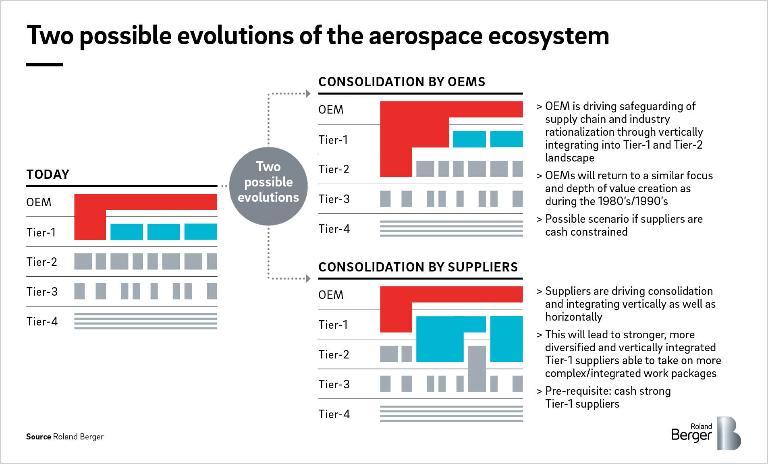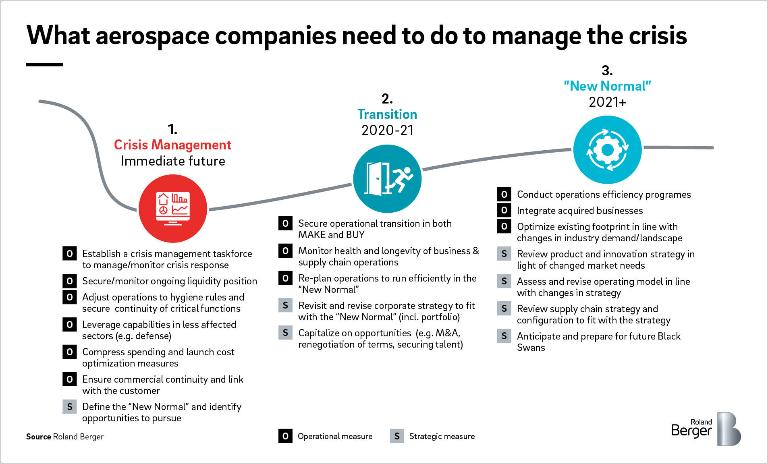Manfred Hader
SENIOR PARTNER, CO-HEAD OF GLOBAL AEROSPACE & DEFENCE PRACTICE
Hamburg Office, Central Europe
+49 40 37631-4327
Plunge in air traffic will deeply impact demand for new aircraft
The COVID-19 pandemic has the potential to trigger a global economic crisis of significant dimensions, affecting all industries. One of the industry sectors in the eye of the coronavirus storm is aerospace. Global air traffic has been brought to an almost complete standstill by the COVID-19 outbreak. While air traffic has consistently shown a solid recovery from previous crises, the debate is wide open about how traffic will recover following the current crisis and what this will mean for the civil aircraft manufacturing industry, the supply chain and aftermarket support businesses.
Previous crises like 9/11, SARS or the financial crisis of 2008/09 all demonstrated a recovery along V- or U-shaped curves back to the pre-crisis growth path. As COVID-19 is a fully global crisis of unprecedented magnitude, we need to consider whether we might see an L-shaped recovery with consistently lower levels of air traffic and permanently slower growth after the crisis.
The debate is fueled by two questions for which there is no real precedent to extrapolate from but which could be transformational for the industry:
- What is the magnitude of the COVID-19 crisis, and will it change the way we perceive air transport?
- Will the crisis highlight obsolete industry structures and cause the bubble of huge aircraft orderbooks to burst?
This article discusses three key questions:
- 1. How deep will the crisis be for aviation, and how long will it last?
We examine different scenarios for global air traffic development in the coming years.
- 2. What will be the impact on the aerospace industry?
We derive the impact of these scenarios on the demand for new aircraft and MRO (maintenance, repair and operations).
- 3. What needs to be done to manage the crisis?
We discuss what the aerospace industry could look like in a post-COVID-19 world and what measures need to be taken to mitigate risks and capture opportunities.
1. How deep will the crisis be and how long will it last?
The magnitude of the air traffic crisis can be characterized by four key indicators:
The longer the restrictions last, the more airlines will run out of liquidity, leading to bankruptcies, nationalizations or consolidation, hence causing an irreparable change in the industry landscape and customer structure for aircraft manufacturers. Moreover, the longer the restrictions last, the greater the possibility that temporary behavioral changes imposed by the pandemic may become permanent (e.g. reduction of business travel as a result of increased digital communication).
Once the air travel restrictions are lifted, the time to recovery will be impacted by potential new outbreaks of the disease, leading to recurrent waves of further travel restrictions and hence fluctuating travel volume at lower levels.
The combination of a long duration of travel restrictions and repeated outbreaks over an extended period of time might lead to a "new normal", with global air traffic volumes settling at a lower level – an effect that has never occurred before in the history of commercial aviation.
The combination of a long duration of travel restrictions and repeated outbreaks over an extended period of time might lead to a "new normal", with global air traffic volumes settling at a lower level – an effect that has never occurred before in the history of commercial aviation.
3. What needs to be done to manage the crisis?
It can already be anticipated that the post-crisis aerospace industry will not look like it did before the crisis:
- Significant downsizing of operations is to be expected for both OEMs and suppliers – the industry will need to offset the resulting loss of scale with a step up in efficiency, potentially taking advantage of the crisis to take actions that would be unpalatable in easier times.
- Weaker suppliers (e.g. those with heavy exposure to the B737, more aftermarket exposure and less counter-cyclical defense business) will come under severe financial pressure.
- A significant consolidation of the industry by companies with strong balance sheets must be expected, either to take advantage of distressed assets or to bail out suppliers to safeguard the stability of their supply chain.
One of two possible post-crisis industry models could emerge:
- 1. A more OEM-centric industry model whereby the OEMs consolidate key parts of the supply chain to stabilize and rationalize it.
- 2. A more balanced industry model between OEMs and key Tier-1 suppliers, where the Tier-1s have consolidated even more, amassed scale and are now on a level playing field with the OEMs.

As the aerospace industry relies on a highly interconnected and mutually dependent supply chain, the crisis needs to be managed on two levels in parallel:
On an individual company level, cash will be king. Protecting cash positions will be key to ensuring survival while managing the ramp-down, stabilizing and securing the supply chain and seizing opportunities in the market – we may therefore expect a cash squeeze in May and June as new production schedules become established but activities have not yet been rationalized. Preparing for the "new normal", rightsized and potentially repositioned operations must start immediately. To this end, the company's strategy, its industrial footprint and operating model, needs to be reviewed and a blueprint developed to fit with the "new normal" and provide the right framework for short-term actions and strategic moves.

At industry level, companies and governments will need to work closely together to ensure that key industrial capabilities do not fall through the cracks, as this would put the whole industry at risk. Therefore, the industry will have to:
- Quickly reach a consensus on the "new normal" production rates
- Define a joint plan for how to transform the industry from its status quo to the "new normal" level
- Identify at-risk elements in the transition process and develop plans to support them
Once this picture is clear, government support may need to be called upon to safeguard the short-term functioning of the industry and help manage the transition to the "new normal" for this strategically important sector.
https://www.rolandberger.com/en/Point-of-View/COVID-19-How-we-will-need-to-rethink-the-aerospace-industry.html




